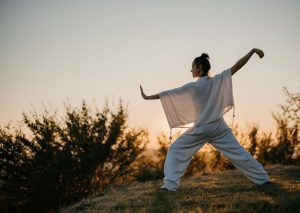Tai Chi Chuan, Qigong and Yoga as Mind-Body Exercises

What is depression?
February 21, 2023
The Benefits of Meditation and Relaxation for Children
April 10, 2024As years pass by, the practice of Mind-Body exercises has become increasingly common in Western countries. As a result, in the last few years, the number of people seeking to explore unity consciousness with activities such as Tai Chi, Qigong, and Yoga has grown as a way of exercising the body, stretching, and even relaxing. Mindful exercise can also complement and serve as an alternative to conventional exercise programming.
To understand the historical origins of these classical mindful exercises traditions and their relevance to the contemporary mindful exercise was one of my goals while living in Asia and travelling extensively through China and India.
So without further ado, let’s align mind and body and explore the disciplines of mindful exercise:
Yoga
Yoga is a mindful exercise that has its origin in India, more than 5000 years ago, and is currently known not only as a philosophy of life but also as a holistic system that works both body and mind at the same time. Yoga works on emotions, helps people to act according to their thoughts and feelings, in addition to bringing deep relaxation, concentration, mental tranquillity, strengthening of the physical body and the development of flexibility.
This ancient science aims to unite the body, mind, and spirit allowing people to reconnect with their true essence. According to Spiritual Master Sri Sri Ravi Shankar, “Yoga gives you the power to feel the way you want to feel, at any time, without being a victim of your own feelings.” Yoga also means to control. It is a term of Sanskrit origin, a language present in India, especially in the Hindu religion. Yoga is a concept, a philosophy, which works the body and mind, through traditional disciplines of those who practice it.
Yoga is related to Buddhism and Hinduism, with practices such as exercise and meditation to work on the physical as well as the mind. There are several branches of yoga, such as Vinyasa-yoga, Karma-yoga, Bikram-yoga, Ashtanga-yoga and Hatha-yoga, each of which has different actions and activities.
For a long time, yoga remained restricted to some cultures, especially those of the East. Their techniques were passed down from generation to generation of masters, who taught their disciples the deepest knowledge. Here in the West, it took a long time for science to make advances that would allow the recognition of such practices, and with that thousands of years passed without Western culture having access to the benefits that the practice of Yoga can offer to each individual.
Today, scientific research is already able to recognize the connection between energy and matter. Several branches of physics then began to look more closely at the way Yoga, meditation, and breathing techniques have the power to alter the energy of our body, producing very beneficial transformations, not only for the person who practices but also for the environment around you. Basically, Yoga is much more than just a set of twisting, stretching movements, mixed with some complex and challenging postures.
Tai Chi Chuan
In every single town and city, I have visited in China, I would find people doing slow, harmonious and circular movements in parks and squares mainly in the mornings.
Quickly I’ve discovered that it was Tai Chi Chuan, an ancient practice that was born in China as a martial art, but today it is better known as a form of meditation and physical activity.
Chinese legend tells that the practice was created by the Taoist master Chang San Feng, after observing the fight between a heron and a snake. During the fight, the animals, each with its own characteristics, demonstrated flexibility, lightness, energy, speed and accuracy. Yet, they also demonstrated special abilities to remain in the struggle for long periods. The fight between the two animals lasted a long time and served as inspiration and led Chang San Feng to develop the techniques of Tai Chi Chuan.
Tai Chi Chuan early practitioners, in addition to living in the isolated mountains of China practising inner calm, also had to defend themselves against the intermittent invaders of the time. The practice of Tai Chi Chuan has always served the need for both “internal cultivation” and “struggle” of these people since it unites concepts of strength and softness. This martial art is practised with movements performed slowly and in silence, providing the movement of the body’s energy and stimulating body awareness, concentration and tranquillity.
This practice is also known as meditation in movement, and it is widely performed both as a self-defence sport, but also for therapeutic purposes, as its exercises bring benefits such as correcting posture, balance and strength, in addition to harmonizing emotions and combat mental illnesses like anxiety and depression. Tai Chi Chuan is one of the simplest and easiest martial arts, it can be practised by anyone and started at any age, and is also very suitable for the elderly. It is recommended to use soft shoes and comfortable clothes that do not hinder the performance of movements. It can also be practised anywhere, but preferably outdoors.
Qigong
Qigong (pronounced “tchikon”) is an ancient therapeutic technique from ancient China. “Qi” means energy, vital breath, and “Gong” means work, cultivation, training. So Qigong would be work, training and cultivating our vital energy in your physical and mental practice.
This discipline has more than 5000 years of existence and it is an art of personal development that has stood the test of time. This ancient practice especially indicated to balance the energy of the body and mind through a series of simple postures and movements, as well as self-massage and meditation.
The ancient experience with the effects of his practice has been accumulated over successive generations. For this reason, Qigong is a discipline made up of a complete set of physical, respiratory, mental and spiritual exercises, properly purified of any adverse elements and with clear objectives and well-defined results. In Qigong, the exercises are gentle, while pleasure and well-being are references that allow us to assess the quality of the exercise.
Qigong’s principles are based on Taoist philosophy and Traditional Chinese Medicine and were first published in the Yellow Emperor’s internal canon. This book is considered the head of the source of the ancient Chinese medicine system. Qigong is believed to be able to cure illnesses to improve the practitioner’s physical and mental health.
Qigong has three forms: medical qigong, meditation qigong and martial qigong. Qigong is used in Traditional Chinese Medicine as a preventive and therapeutic method. Regular exercise improves health and vitality, harmonizes energy systems, increases the flow and quality of vital energy (Chi, Ki or Prana) to the internal organs and helps the expansion of consciousness.
Qigong is a form of meditation that allows you to make your inner, physical and psychic experiences clear, and to relive past experiences full of health, joy and happiness.
Consciously recalling this type of experience reactivates the unconscious memories of vitality and health that are stored in the cells of the physical body and that will enrich and quicken the practice of exercises so that their preventive and curative effects are amplified.
Qigong was not created by a single individual and results from thousands of years of the Chinese experience in using energy to treat disease, promote health and longevity, improve fighting skills, expand the mind, reach different levels of consciousness and develop spirituality. The various Qigong techniques have developed separately in different parts of China, but in many cases, they have influenced each other.
Hope you find these mind-body exercises helpful and manage to get curious about adding them into your routine.
Cultivating health by mastering Qi or Chi is the ultimate goal of Qigong, as is Tai Chi. This includes creating difficult body postures in the same way as yogis in India. The mind’s focus on doing the postures helps the practitioner’s mind, breathing and energy.
They have personally been very helpful through my journey as they have enabled me to control my life while benefiting physically, mentally, spiritually and emotionally.
And if you liked this content, I invite you to leave a comment, telling me what you think and which one of these mind-body exercises you prefer or are more curious about, to share it on your social networks and to continue following us.






